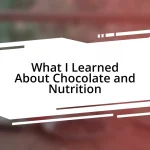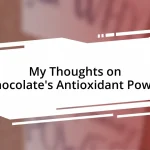Key takeaways:
- Quality chocolate, especially dark chocolate with higher cocoa content, significantly enhances dessert flavors and textures.
- Investing in essential baking tools like a stand mixer and accurate measuring cups improves efficiency and results in the kitchen.
- Proper techniques such as gentle mixing, using room temperature ingredients, and allowing desserts to cool can elevate the final product.
- Effective storage methods and creative decorating can maintain the quality and presentation of chocolate desserts over time.

Choosing the right chocolate
When it comes to choosing the right chocolate for your dessert, I’ve learned that quality makes all the difference. I remember the first time I used single-origin chocolate for a cake; the rich, complex flavors elevated my dessert to a whole new level. Isn’t it amazing how a small choice like this can transform your creations?
I often find myself torn between milk and dark chocolate. Each has its charm, but my personal favorite for desserts is dark chocolate, especially with a higher cocoa percentage. There’s something incredibly satisfying about its bittersweet nature, and I think it creates a balance that’s hard to beat. Have you ever noticed how a good dark chocolate can awaken other flavors in your dish?
Don’t forget about chocolate’s texture, too! A silky smooth chocolate can make a ganache that feels like a hug in your mouth, whereas a coarser chocolate can add delightful crunch. I once experimented with chocolate chips that were less refined, and the outcome was surprisingly delightful! What specific textures do you enjoy in your desserts?

Understanding chocolate types
Understanding the different types of chocolate is essential for anyone looking to elevate their dessert game. Each type brings its unique flavor profile and texture to the table. I remember a time when I experimented with white chocolate, thinking it might complement a berry tart. The result was surprisingly divine! Its creamy sweetness paired beautifully with the tartness of the berries, creating a harmony I hadn’t expected.
The cocoa content plays a significant role in the bitterness and sweetness of chocolate. Dark chocolate typically contains at least 50% cocoa, while milk chocolate blends cocoa with milk and sugar, resulting in a creamier texture and sweeter taste. This revelation hit me hard when I first tasted a high-percentage dark chocolate – I couldn’t believe the depth it added to my brownies. Have you ever tried to adjust the cocoa content in your recipes? It can lead to incredible discoveries!
When deciding on the chocolate type, don’t overlook the brand’s quality. I once used a bulk-brand chocolate for a ganache, and the difference was striking compared to my usual choices. The bitterness was harsh, and the texture felt off. Trust me, investing in good chocolate is always worth it. Pay attention to how the chocolate cooks and melts, too—these little details can greatly impact your dessert’s final taste and presentation.
| Chocolate Type | Cocoa Content |
|---|---|
| Dark Chocolate | 50% – 90% |
| Milk Chocolate | 10% – 50% |
| White Chocolate | 0% – 35% |

Essential tools for baking
When I began baking, having the right tools transformed my experience in the kitchen. It’s like stepping onto a stage with backstage access—everything feels more exciting and efficient. I recall purchasing my first stand mixer; the ease with which it whipped cream and blended batter made me feel like a professional. With the right tools, you can focus on creativity instead of wrestling with your ingredients.
Here are some essential baking tools that I find invaluable:
- Stand Mixer: Perfect for whipping, mixing, and kneading.
- Measuring Cups and Spoons: Precision is key in baking, and these are your best friends.
- Baking Sheets: A sturdy, non-stick surface is essential for evenly baked goodies.
- Mixing Bowls: Having various sizes allows for efficient ingredient preparation.
- Spatula: A silicone spatula helps you scrape every last bit of that chocolate batter.
- Whisk: Ideal for incorporating air into your mixtures and smoothing out lumps.
- Cooling Racks: Essential for allowing your baked goods to cool evenly, preventing sogginess.
Investing in these tools not only enhances your baking skills, but it also brings a sense of joy as you see how easily they can elevate your creations. The moments when I flawlessly blend a cake batter or perfectly whip cream are when I fully appreciate the comfort and satisfaction these tools bring to my baking journey.

Techniques for perfect desserts
Techniques for perfect desserts
One vital technique I always emphasize is proper mixing. When I first started baking, I remember overmixing my cake batter, thinking more was better. It wasn’t until I made a few dense cakes that I learned the importance of mixing just until combined. A gentle fold can retain air, ensuring a light and fluffy texture. How do you check if your batter is ready? I find that the batter should have a slight sheen and flow together smoothly, like a thick ribbon.
Temperature matters, too. For instance, always use room temperature eggs and butter unless the recipe specifies otherwise. I made the mistake of using cold butter once in a cookie recipe, and the dough became so crumbly that it was nearly impossible to shape. Since that day, I always ensure my butter is soft, which makes for a creamy, cohesive dough. Have you ever noticed how this simple adjustment can transform your desserts from decent to delightful?
Lastly, patience is often an unsung hero in baking. When I learned to let desserts cool properly before serving, it changed everything. I used to dive in too soon, only to end up with a molten mess. Taking that extra time to allow my chocolate mousse to set or my cheesecake to firm up created moments of sheer perfection. Waiting might feel challenging, but trust me, the flavor and texture payoff is worth every second! What’s a dessert you love but find hard to wait for?

Common mistakes to avoid
One of the most common mistakes I see is not measuring ingredients accurately. Early on, I had a disastrous batch of brownies because I approximated the measurements, thinking it wouldn’t matter. Trust me, a couple of extra tablespoons of flour can turn fudgy goodness into dry, crumbly bars. Have you ever experienced that? Precision is your ally when it comes to baking.
Another pitfall is forgetting to line your baking pans. I once thought I could skip this step for a chocolate lava cake, convinced that it would slide out easily. Instead, I ended up with a collapsed dessert stuck to the bottom of the pan. It was heart-wrenching to see all that chocolatey goodness go to waste. So, always remember to line or grease your pans properly; it can save you from a sticky situation!
Lastly, not giving your desserts enough time to chill or set is a mistake we all make from time to time. I can vividly recall the excitement of pulling a cheesecake out of the oven, only to gobble it up while it was still warm. The result? A delicious but gooey mess that fell apart when I tried to slice it. Letting desserts cool—or chill in the fridge—makes a significant difference. Wouldn’t you agree that a perfectly set dessert is more satisfying than a squishy one? Always allow your creations to reach their full potential; they’ll love you for it!

Storing chocolate desserts
When it comes to storing chocolate desserts, I’ve learned a few key strategies to keep that rich flavor and delightful texture intact. For example, I remember a time when I hurriedly placed my leftover chocolate cake in the fridge without covering it, and the next day, it was dry and lost that heavenly taste. Now, I always wrap my desserts tightly in plastic wrap or store them in an airtight container to retain moisture and flavor. Have you experienced the disappointment of a dessert going stale? Trust me, a little extra effort in wrapping can go a long way.
Refrigeration is particularly crucial for delicate desserts like mousse or ganache. I once left a chocolate mousse uncovered in the fridge, and the top developed an unsightly crust. It was a lesson learned on the importance of keeping those treats sealed. Also, when it comes to storing brownies or bars, cutting them into portions before wrapping makes serving a breeze. Who doesn’t love reaching for a ready-to-eat square of chocolate goodness?
For longer storage, freezing is a fantastic option, but not all chocolate desserts behave the same way once thawed. I found that while cookies hold up well, a layered chocolate cake can get a bit soggy if not wrapped properly. My tip? Freeze individual slices instead of the entire cake. That way, you can enjoy them gradually without sacrificing quality. Have you ever thawed a dessert only to be disappointed? Taking a moment to think about how you’ll store leftovers can enhance your chocolate experience down the line.

Decorating your chocolate creations
When it comes to decorating your chocolate creations, I can’t stress enough how much fun it is to express your creativity! I remember the first time I experimented with chocolate shavings—they added an elegant touch to my ganache-covered cake. It was like a little burst of joy each time someone marveled at my decorative flourish. Have you ever played around with toppings? Simple additions, like sprinkles or edible flowers, can elevate your dessert from ordinary to extraordinary.
Another trick I’ve picked up is using a piping bag for drizzling melted chocolate. The first time I balled a bag too tightly, it burst, and I was left with a bit of a mess. Yet, that experience taught me that patience is key to getting those neat lines across a tart or brownie. Watching the chocolate cascade down a dessert can be so satisfying—almost like watching art come to life! And when it comes to enhancing flavor, a touch of sea salt over your chocolate can create a delightful contrast. Have you tried it yet?
Don’t shy away from blending textures, either. I often sprinkle crushed nuts or cookie crumbs over my desserts. The crunch against the smooth chocolate creates a multi-sensory experience that really speaks to my love for dessert crafting. Once, I topped a chocolate mousse with a layer of crushed hazelnuts, and their nutty richness perfectly complemented the chocolate’s decadence. Can you imagine the satisfaction when friends dug in and enjoyed every bite? Each sprinkle adds not just beauty but an invitation to indulge.














